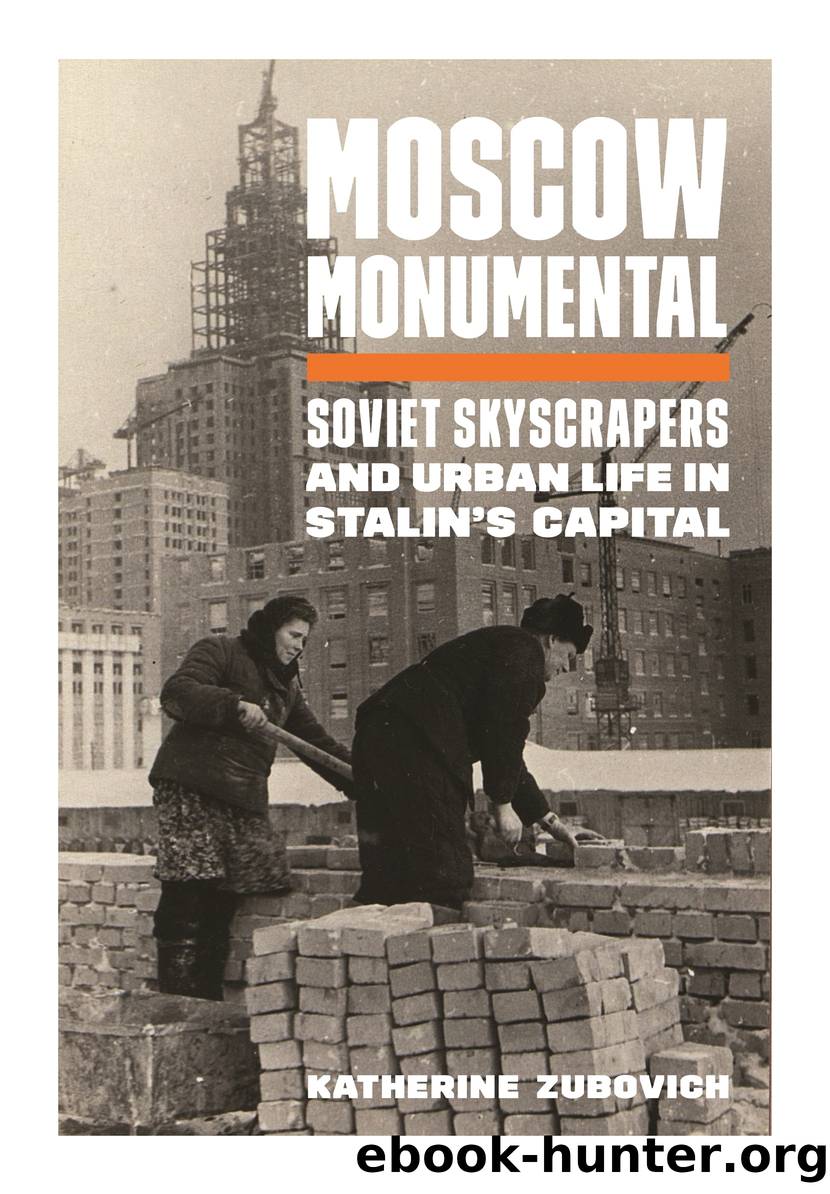Moscow Monumental by Katherine Zubovich

Author:Katherine Zubovich
Language: eng
Format: epub
Publisher: Princeton University Press
Published: 2020-10-20T00:00:00+00:00
Figure 6.7: Construction of Moscow State University, 1951. Collection of the Moscow City Archive GBU âTsGA Moskvy.â
Figure 6.8: Construction of Moscow State University, 1951. Collection of the Moscow City Archive GBU âTsGA Moskvy.â
Posters and newspaper reports of the postwar years rarely, if ever, depicted women working in skyscraper foundation pits. Instead, women were shown working as bricklayers or more commonly as stuccoists or modelers (lepshchiki), adding the final decorative touches to a buildingâs façade. By locating women on the façades of Moscowâs skyscrapers, artists and writers worked to reinforce traditional gender roles after a war during which female combatants and partisans on the frontlines, and women workers on the home front, had interrogated those roles. In a painting created in the late 1940s, for example, the artist Georgii Satelâ pictured a young woman on one of Moscowâs skyscraper sites; wearing summer shoes and a clean white smock over her dress, she is shown taking instruction from an older male craftsman. The painting, titled âThe Komsomol-Builders of Moscow,â was shown at the All-Union Art Exhibition in 1949 and published in Ogonek the following year. The men in Satelâs painting give direction and they do the heavy lifting, passing up the premade acanthus leaves that will decorate one of the buildingâs columns. The woman in white, by contrast, stares intently at a spiral-shaped corner volute of a Corinthian capital while being shown how to carve it. Her clean, white drapery looks nothing like the quilted jackets (telogreiki)âor even the lighter jackets and overalls for warmer weatherâworn by the typical vysotnitsa, but this was of little matter. Like so many women draped in white before her, the figure in Satelâs painting is an allegory for peace and the purity of the tasks that lay ahead.
Both women and men worked on the façades of Moscowâs skyscraper construction sites as modelers. Photographs taken on the MGU site in 1951 show a group of workers arranging ceramic tiles atop rows of bricks. One of the workers assembles a floral medallion. All are wearing matching dark coveralls (fig. 6.9â6.10). Elsewhere on the MGU construction site, archival photographs seem to confirm the more idealized images produced by artists like Satelâ. In a photograph taken in 1950, women are shown working in clean light clothing and high heels, with hair tied back just so (fig. 6.11); the woman in the white top in the foreground has mislaid her gloves. The contrast in dress and facial expression between the two women in front and the other seven in the back gives the image a staged quality. Whether the women pictured traded in their work boots and headscarves of their own accord, or whether they were asked to do so ahead of the photographerâs visit to the construction site, photographs like this one show the importance of making women visible on the construction sites, even if this visibility was accompanied by unrealistic representation.
Figure 6.9: Construction of Moscow State University, 1951. Collection of the Moscow City Archive GBU âTsGA Moskvy.â
Download
This site does not store any files on its server. We only index and link to content provided by other sites. Please contact the content providers to delete copyright contents if any and email us, we'll remove relevant links or contents immediately.
| Africa | Americas |
| Arctic & Antarctica | Asia |
| Australia & Oceania | Europe |
| Middle East | Russia |
| United States | World |
| Ancient Civilizations | Military |
| Historical Study & Educational Resources |
Rasputin by Joseph T. Fuhrmann(561)
Russian Revolution: A Concise History From Beginning to End (October Revolution, Russian Civil War, Nicholas II, Bolshevik, 1917. Lenin) (One Hour History Revolution Book 3) by Hourly History(334)
The Russian Revolution: A Very Short Introduction (Very Short Introductions) by S. A. Smith(332)
FROM RUSSIA, WITH LOVE by Ian Fleming(323)
Moscow Monumental by Katherine Zubovich(320)
The Russian Five by Keith Gave(310)
Reconstructing Lenin: An Intellectual Biography by Krausz Tamás(303)
Authoritarian Nightmare by John W. Dean & Bob Altemeyer(299)
Winter is Coming by Gary Kasparov(297)
Kremlin Rising by Peter Baker(274)
Io dirò la verità by Germano Maifreda(258)
Spetsnaz: The Inside Story of the Soviet Special Forces by Viktor Suvorov(243)
Russia Resurrected by Kathryn E. Stoner;(234)
My Further Disillusionment in Russia by Emma Goldman(233)
Voices From Stalingrad by Bastable Jonathan;(227)
13 KGB by Unknown(217)
The Russian Revolution in Ukraine (March 1917 â April 1918) by Nestor Makhno & Nestor Makhno(212)
Jihad and Death by Roy Olivier;(201)
Russian Revolution, 1917 (9781108109161) by Wade Rex A(188)
